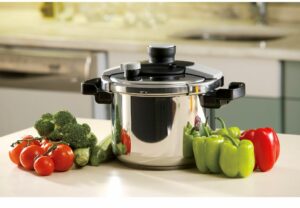
We’ve focused on the addition of acid or sugar in addition to heat as food preservation methods. But it is possible to preserve foods that are naturally low acid using high heat delivered through pressure canning.
Low-acid foods have a pH level higher than 4.6 and include vegetables, meat, poultry, seafood, and any sauces, soups or stews that contain these ingredients (e.g. a tomato and meat sauce). These foods can all be preserved but that must be done through pressure canning to eliminate the risk of botulism.
Pressure canning uses a different process from canning using a boiling-water bath.
A pressure canner, like a pressure cooker, creates an internal pressure that forces food to cook very quickly. A pressure canner has a lid that seals and a gauge to indicate the pressure the food inside the canner has reached. Liquids under pressure can boil at a higher temperature than liquids at normal pressure.
Boiling-water-bath canning raises the internal temperature of a preserved food to a maximum of 100C (212F) – the boiling point of water. That temperature is sufficient to destroy any microbes that might survive the inhospitable environment created by the addition of acid, salt, or sugar to the preserved food.
Under pressure, water can boil at temperatures up 240°F (116°C). Because low-acid preserved foods don’t inhibit bacterial growth from salt, acid or sugar, these foods need higher and more prolonged heat to kill off any bacteria or spores that can be lurking in the preserves.
Recipes that require pressure canning will indicate what pressure to use and how to adjust that pressure depending on what altitude you live at. Higher altitudes require higher cooking pressure.
Used for preserving | Used when preserving low-acid foods | Used when preserving foods that have salt, acid or sugar added | |
Pressure canning | Yes | Yes | Yes, but not necessary |
Water bath canning | Yes | No | Yes |
Pressure cooker | No | No | No |
Because the temperatures in the pressure cooker get so high, you do not need to sterilize your clean jars and lids before you fill them. Just as with regular canning, the lids you use will create a seal as the preserved food inside the jar cools. A convex or indented lid indicates that the preserves are properly sealed.
The bacteria, Clostridium botulinum, can be present in any food and grows best when there is no oxygen present. While the bacteria itself is killed at 100C or 212F, it produces hardy spores that survive this temperature. These spores thrive:
As they grow, these spores give off a deadly toxin that is invisible and has no odor or taste, making it impossible to detect in food at home. The botulism toxin affects the nervous system and causes paralysis. It can be fatal.
The higher temperature produced through pressure canning kills both the Clostridium botulinum bacteria and its spores.